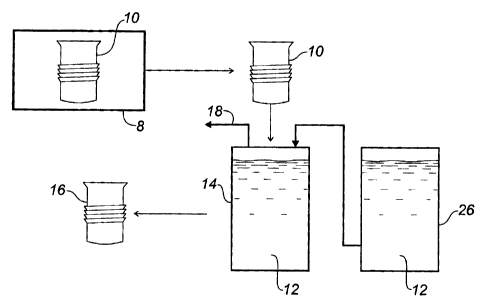Some of the information on this Web page has been provided by external sources. The Government of Canada is not responsible for the accuracy, reliability or currency of the information supplied by external sources. Users wishing to rely upon this information should consult directly with the source of the information. Content provided by external sources is not subject to official languages, privacy and accessibility requirements.
Any discrepancies in the text and image of the Claims and Abstract are due to differing posting times. Text of the Claims and Abstract are posted:
| (12) Patent: | (11) CA 2240226 |
|---|---|
| (54) English Title: | POLYMER PLASTIC PLUG IMPREGNATED WITH WOOD PRESERVATIVE AND METHOD FOR MAKING THE SAME |
| (54) French Title: | CHEVILLE EN MATIERE PLASTIQUE POLYMERIQUE IMPREGNEE D'UN PRODUIT DE PRESERVATION DU BOIS, ET METHODE DE FABRICATION CONNEXE |
| Status: | Expired |
| (51) International Patent Classification (IPC): |
|
|---|---|
| (72) Inventors : |
|
| (73) Owners : |
|
| (71) Applicants : |
|
| (74) Agent: | WOODRUFF, NATHAN V. |
| (74) Associate agent: | |
| (45) Issued: | 2009-03-24 |
| (22) Filed Date: | 1998-06-10 |
| (41) Open to Public Inspection: | 1999-12-10 |
| Examination requested: | 2003-06-06 |
| Availability of licence: | N/A |
| (25) Language of filing: | English |
| Patent Cooperation Treaty (PCT): | No |
|---|
| (30) Application Priority Data: | None |
|---|
A method of impregnating a polymer plastic plug with wood preservative. A first step involves dehydrating a polymer plastic plug to reduce its naturally occurring moisture content. A second step involves introducing liquid wood preservative into the polymer plastic plug while the polymer plastic plug is in a dehydrated state by immersing it in the liquid wood preservative and boiling the liquid wood preservative at temperatures that are less than that required to turn the polymer plastic plug into a molten state. In accordance with the teachings of this method liquid wood preservative is absorbed into the dehydrated polymer plastic plug in place of the naturally occurring moisture content.
Méthode pour imprégner une cheville en plastique polymérique avec un agent de préservation du bois. La première étape consiste à déshydrater une cheville en plastique polymérique afin de réduire son taux d'humidité naturel. La deuxième étape consiste à introduire l'agent de préservation du bois liquide dans la cheville en plastique polymérique pendant que cette cheville est à l'état déshydraté, cela en immergeant celle-ci dans l'agent de préservation du bois liquide que l'on fait bouillir à des températures inférieures à celles requises pour que la cheville en plastique polymérique fonde. Selon cette méthode, l'agent de préservation du bois liquide est absorbé dans la cheville en plastique polymérique, où il remplace l'humidité présente naturellement.
Note: Claims are shown in the official language in which they were submitted.
Note: Descriptions are shown in the official language in which they were submitted.

For a clearer understanding of the status of the application/patent presented on this page, the site Disclaimer , as well as the definitions for Patent , Administrative Status , Maintenance Fee and Payment History should be consulted.
| Title | Date |
|---|---|
| Forecasted Issue Date | 2009-03-24 |
| (22) Filed | 1998-06-10 |
| (41) Open to Public Inspection | 1999-12-10 |
| Examination Requested | 2003-06-06 |
| (45) Issued | 2009-03-24 |
| Expired | 2018-06-11 |
| Abandonment Date | Reason | Reinstatement Date |
|---|---|---|
| 2007-12-20 | R30(2) - Failure to Respond | 2008-05-12 |
Note: Records showing the ownership history in alphabetical order.
| Current Owners on Record |
|---|
| 1824930 ALBERTA LTD |
| Past Owners on Record |
|---|
| GENICS INC. |
| GENICS-CAN INC. |
| WALL, WESLEY JAMES |